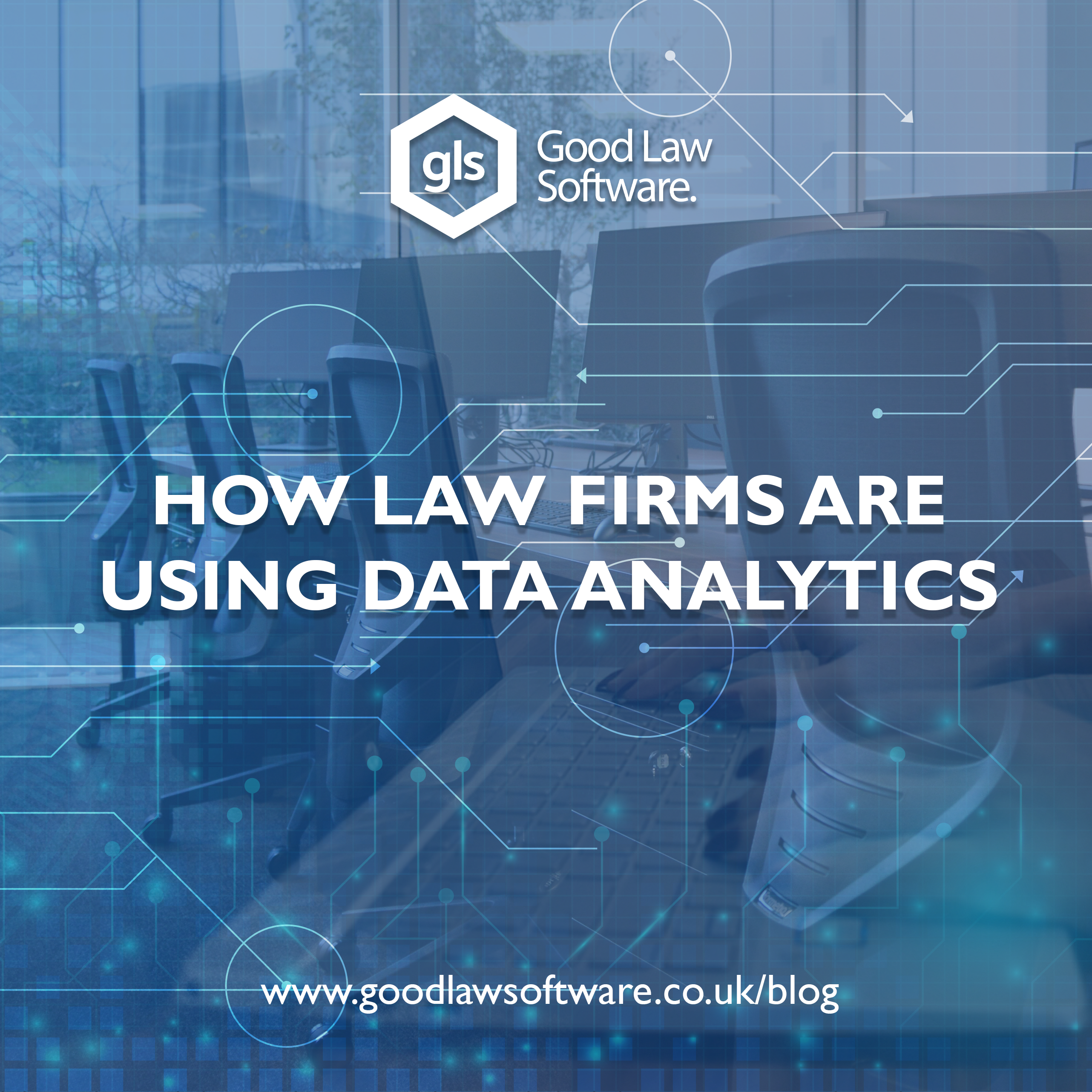How Law Firms are Using Data Analytics

Written by Maryam Khan
Blogger

Data analytics have recently become crucial across various industries as a deep understanding of data is pivotal to building a successful business practice. Law firms can now make more accurate and objective decisions through data analytics while gaining deeper insight into their client activity. The high volumes of data available today make traditional means of collecting, storing and presenting information obsolete. This shift is exactly why law firms are starting to use data analytics to transform their business functions.
What Are Data Analytics?
Data analytics refers to the science and method used to gather, process, examine and categorise raw data sets to gain insight into how businesses or any other working models operate to meet business goals. It does this by making accurate predictions and better strategic decisions. In simple terms, it is the process through which raw data becomes valuable knowledge that can then transform an organisation. The key decision-makers can use this valuable knowledge to interpret large volumes of data to take calculated risks, better understand past trends and predict future ones [1].
Unstructured and Structured Data
All data is not the same. Most data is unstructured, but some data can also be structured. Therefore, learning about the differences between the two is essential to understand your law firm’s business needs better. This understanding is especially important if you want to use data analytics to develop firm insights since structured and unstructured data are collected and stored in different ways and on different databases [2].
Unstructured data refers to qualitative data that cannot be processed and analysed through traditional means of data analysis. Such data does not have a definitive data model, which is why cloud data lakes are used to preserve them in their raw form. A cloud data lake is a mechanism that processes large volumes of data into analytics, enabling law firms to generate unique business insights [3]. Examples of unstructured data include text, IoT sensor-generated data, mobile and social media activity. The benefit of using unstructured data is that it can be collected quickly and easily. Additionally, due to its unstructured nature, it is adaptable in terms of file formats which widens the data pool, enabling only the necessary data to be prepared and analysed [4].
On the other hand, structured data refers to quantitative data that is easily deciphered by artificial intelligence. The benefits of structured data are extremely specific and can be easily used by machine learning algorithms already widely adopted in the legal sector. Moreover, structured data is easily interpreted and does not require an in-depth understanding of various data types, making it convenient for business use. However, compared to unstructured data, there are limited storage options for structured data as they are often stored in data warehouses where it is difficult to make any changes if needed [5].
How Does Data Analytics Work?
Understanding the wider benefits of data analytics requires understanding the life-cycle of transforming raw data into actionable knowledge. The data analytics process can be categorised into four main stages; collecting data, processing data, cleaning data and analysing data.
Collecting Data
The first stage is data collection, where data is extracted from various sources and moved to a system where it can be securely stored. The entire data collection process is largely dependent on the company and its existing operations. The data collection process runs throughout the entire data life cycle as there are times when data is collected but never further analysed or used. This category of data is known as ‘dark data. However, this can be avoided through advancements in technology as now, real-time analytics of streaming data can occur alongside the data collection process. This side by side collection and analysis is referred to as edge analytics which involves IoT devices and sensors gathering both structured and unstructured data from multiple devices such as connected equipment, streetlights and machines [6].
Sorting Data
Structured data collected can then be stored in a data warehouse where business intelligence tools and solutions can easily access it. On the other hand, raw or unstructured data is quite large and stored in a cloud data lake instead of a warehouse.
Processing Data
Once data is collected and stored, the next stage is processing. In this stage, the data is prepared for use by storing information in an accessible system. The collected data must be properly organised to ensure accuracy, especially if unstructured data is being dealt with. Data processing options include batch processing and stream processing. The first deals with large data blocks over time, while the latter looks at small data blocks [7]. Each has its benefits, which often depend on the immediate and long-term goals of the law firm.
Cleaning Data
Before being stored, the data is cleaned and transformed into information that can be easily understood and accessed. The types of databases used to understand and analyse data are dependent on the format of the data in question. This process is extremely important as the data must be in the correct format, and any repetitive or irrelevant data will need to be removed as ‘dirty data’ can create misleading insights [8].
Analysing Data
Methods such as data mining, predictive analytics, chatbots and deep learning are used to transform data into actionable business insights. Data mining refers to sorting through large datasets to identify patterns whereas predictive analytics involves using a law firm’s archives to determine future trends, risks and opportunities. On the other hand, deep learning has a more human element to it as the method imitates human learning through artificial intelligence to find patterns and commonalities in abstract data [9].
Why Do Law Firms Use Data Analytics?
It has become a major trend in legal operations teams to use data to help manage law firm business operations. Multiple third-party data analytics products help analyse and predict outcomes based on legal information available to the public. Some of the most popular reasons why law firms are turning to data analytics to meet their business expansion goals include: Building client relationships, identifying opportunities and increasing profitability.
Data analytics assists in identifying opportunities to expand and build upon existing client relationships and develop new ones. One of the key drivers of firm profitability is robust client relationships, as satisfied clients generate more business and referral work. Incorporating data analytics into the law firm’s internal financial reporting process allows for heavy data analysis of existing information already stored on clients [10].
With access to this in-depth insight, law firms can pinpoint opportunities for expanding client relationships if any gaps are identified. Such gaps are identified through automated trend analysis, revealing information about clients who might be selling significant assets, raising capital, issuing securities or requiring further legal advice [11]. Moreover, such a system could also create an automatic alert every time a client’s account shows no activity or communication over some time [12]. This improves client management within the business and allows for greater communication, better management of client expectations, and excellent client service.
Improving investment decisions and business growth
In-depth insight and analysis of this information is required to make it valuable so law firms can use it to drive business growth. Understanding existing information creates opportunities to expand work for clients by conducting a data analytics review once a month compared to every six months or every year. Through this frequent analysis, law firms can identify client demands, trends and often identify their needs before the client. Moreover, investment in employees and technology is extremely important to expand a business and boost its growth. Data analytics helps in identifying areas where investment should be allocated depending on its performance and success rate.
Improving marketing results and increasing competitive edge over other law firms
Data analytics also helps with functions outside of legal practice and client management, such as marketing. All successful businesses use data to monitor the effectiveness of their marketing campaigns and understand and target their customer base more effectively, both in terms of client retention. The role of a lawyer is changing now more than ever as clients are expecting more value for money and more than just legal advice. Using data analytics, a law firm can provide more value for money and better differentiate themselves from their competitors. Law firms can build excellent reputations after gaining a better understanding of marketing insights and the overall customer base, using this information to provide better service.
Increasing consumption of external information for more strategic pricing
The access and consumption of external information through data analytics increases transparency in budgets and price certainty. Clients are continuously demanding more transparency in pricing and are requesting specific and detailed information on the time spent on each project task to be provided [13]. This is to cut the clients own costs and understand how lawyers are adding value to the legal services provided. Data analytics can be used here to provide this information and deeper insight to ensure transparency and trust in service pricing.
Moreover, data analytics can also be used to identify the level of profitability in a particular practice area or case time. Law firms are businesses, and any amount of time and effort into service should generate a profit. Data analytics can link billing and practice management systems to identify profitable areas and determine the pricing accordingly.
Increasing adaptability through risk monitoring and reporting
It is essential for law firms to monitor their risk in a timely manner to adapt to the changing economic and political climate. Data analytics can set automated alerts and reminders, enabling lawyers to swiftly take action to mitigate any risks. Additionally, relevant risk reporting is essential to manage a law firm. Law firms can generate on-demand reports that provide a real-time overview of risks based on past learnings and trends through risk reporting programmed by data analytics [14]. Lastly, a concrete risk management, monitoring and reporting process ensures a competitive edge, stability and long term sustainability.
Are There Any Risks?
Too much data can be overwhelming
A prevailing issue with the usage of data analytics is that it can become difficult to dig beneath the surface and access insights that are often the most relevant to legal practice. Whether a law firm deals with unstructured and structured data becomes important here as both data types have different processing and analysis procedures due to their nature. Additionally, with there being too much data to be processed and analysed, lawyers can sometimes feel overwhelmed, might not fully analyse data and may focus only on data that is easier to collect, process and analyse rather than focusing on data that can truly add value to the business [15]. This is a huge risk to law firms as not having the relevant information can impact a lawyer’s work. To avoid this, law firms should identify their targets in legal analysis and research to ensure correct data is collected.
Privacy and data protection
The General Data Protection Regulation regulates organisations that collect, store and process data to generate analytics. Law firms that use data analytics are data controllers and must only collect and store client data they need and for which they have complete consent. All law firms have a responsibility to ensure a clear process for obtaining consent to process information from all the relevant data subjects; otherwise, they could get into legal trouble and develop a reputation for unethical business practices. This is a huge risk for law firms. It can effect their profitability and position in the legal market.Thus, firms that choose to utilize data analytics need to ensure that all GDPR provisions and compliance requirements are met.
Final Words
The clear need for law firms and in-house legal departments to adopt data analytics to complete their legal function is a clear testament to their usage as certain departments are increasingly asked to report on and operate like other business functions. All in all, data analytics provide the firm with newfound visibility and insight, instil actionable intelligence and allow for informed, better legal decision making. Most importantly, considering how many previous legal decisions were often made by hunches or guesses and considering law firm relationships were based on personal networking, the use of data analytics can give an evidence based direction to such decisions. It is essential, however, to remember that processing data to generate analytics comes with a great deal of responsibility, which is why firms need to ensure they are handling both client and internal information with the utmost care.
References
[1] Ron Friedmann, ‘Better Law Firm Business Decisions with Data Analytics’, Prism legal (2019) at https://prismlegal.com/better-law-firm-business-decisions-with-data-analytics/
[2] IBM Cloud Education, ‘Structured vs. Unstructured Data: What’s the Difference?’ IBM Blog at https://www.ibm.com/cloud/blog/structured-vs-unstructured-data
[3] IBM Cloud Education, ‘Cloud data lake’ IBM Blog at https://www.ibm.com/cloud/architecture/architectures/cloud-data-lake/
[4] Ibid (3)
[5] Ibid
[6] Intel Analytics Hub Page, ‘What is Data Analytics’, Intel (2020) at https://www.intel.co.uk/content/www/uk/en/analytics/what-is-data-analytics.html
[7] Tableau, ‘Big Data Analytics: What It Is, How It Works, Benefits, And Challenges’ at https://www.tableau.com/learn/articles/big-data-analytics
[8] Ibid
[9] Ibid
[10] Promediate, ‘How Data Analytics is Transforming the Legal Industry’ (2020) at https://www.promediate.co.uk/how-data-analytics-is-transforming-the-legal-industry/
[11] Ibid
[12] Ibid
[13] Tiqtime, ‘Why Are Clients Demanding More Transparency and Fixed Fees’ (2018) at https://www.tiqtime.com/blog/why-are-clients-demanding-more-transparency-and-fixed-fees
[14] Vishal Ruia, ‘Role of Data Analytics in Risk Management’ Ernst & Young (2021) at https://www.ey.com/en_in/risk/role-of-data-analytics-in-risk-management
[15] Rebecca Webb, ‘12 Challenges of Data Analytics and How to Fix Them’, Clear Risk (2020) athttps://www.clearrisk.com/risk-management-blog/challenges-of-data-analytics-0








